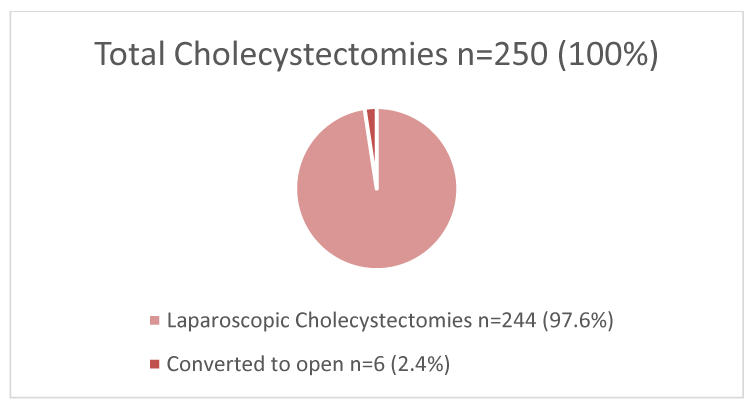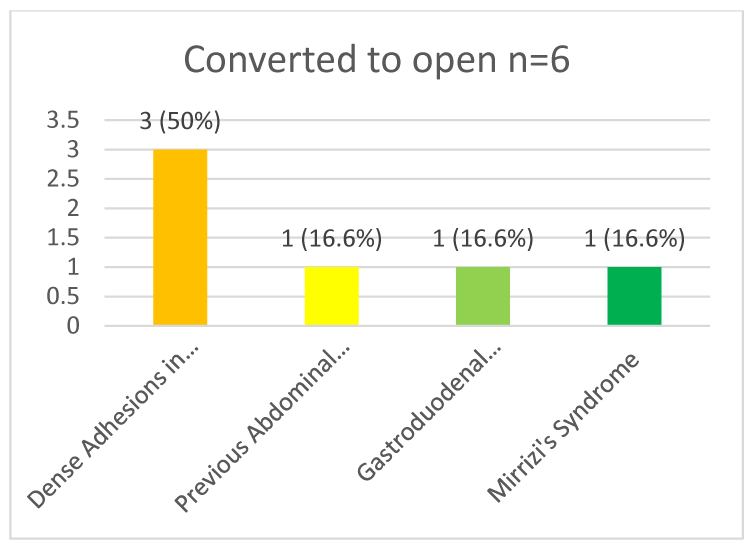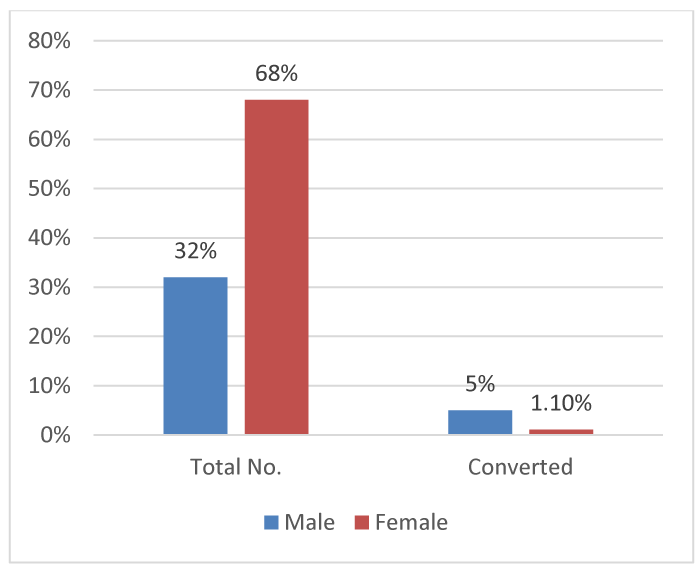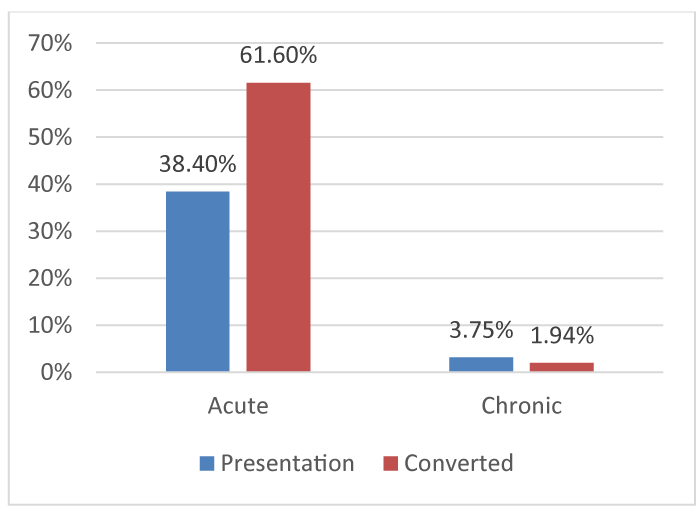Journal of Surgery and Surgical Research
Laparoscopic Cholecystectomy; Conversion Rate, Experience of a Single Surgeon over 4-year period
Ali Javaid1*, Tahir Bashir1 and Maratab Ali1,2
2Doctors Hospital, Lahore, Pakistan
Cite this as
Javaid A, Bashir T, Ali M (2017) Laparoscopic Cholecystectomy; Conversion Rate, Experience of a Single Surgeon over 4-year period. J Surg Surgical Res 3(2): 030-033. DOI: 10.17352/2455-2968.000041To evaluate the conversion rate of lap cholecystectomy and analyze the factors leading to the conversion to open surgery.
Design: Observational Study.
Place and Duration: Department of surgery, Doctor’s Hospital and Azra Naheed Medical College Lahore, Pakistan.
Patients and Methods: We retrospectively analysed 250 patients admitted with gallstone disease who were deemed to be fit for laparoscopic procedure. (June 2011 through May 2016).
Results: The conversion rate in our study was 2.4%. We found it to be significantly lower than the majority of studies. The conversion was mainly due to dense adhesions in Calot’s triangle, previous multiple surgeries, a case of cholecystoduodenal fistula and Mirizzi’s syndrome. The rate of conversion is higher in male patients and in acute cases.
Conclusion: The conversion rate is 2.4% in all the laparoscopic cholecystectomies. Male patients and acute case has a higher probability of conversion. High volume surgeon (>100 cases) as in our study has lower than normal conversion rate.
Introduction
Cholelithiasis is one of most common surgical condition requiring intervention worldwide. Laparoscopic surgery has become the gold standard treatment for gall stone disease since its introduction roughly three decades ago [1,2]. It has been found to be safe and effective in both Acute and Chronic presentation; however, there are still circumstances where Laparoscopic procedure cannot be completed safely and conversion to open surgery is required.
There are multiple factors which leads to conversion of a laparoscopic procedure. These factors can be patient related or surgeon related. Generally, more experienced the surgeon, there is lesser tendency to convert to open surgery. Similarly, difficult anatomy, anatomical anomaly, previous multiple surgeries or iatrogenic injuries are few of them to mention.
Different conversion rates have been reported in different studies worldwide. Generally, it is still considered to be around 5-10% [3]. It is influenced heavily by surgeon’s experience. Low volume surgeons (<100 cases) are more inclined to convert than high volume surgeons (>100 cases) [4].
In this study, we are retrospectively analysing the experience of a single surgeon in performing laparoscopic cholecystectomies over 5-year period and his conversion rate.
Materials and Methods
We conducted our study at Doctor’s Hospital Lahore and Azra Naheed Medical College Lahore. All patients admitted between June 2011 and May 2016 requiring Laparoscopic cholecystectomy were included in the study.
Patients who were planned as open procedure due to anaesthetic reasons (interstitial lung disease/patient operated in high spinal) and Obstructive jaundice patients requiring CBD exploration were excluded.
Data from all the cases were recorded. It included demographics, mode of presentation (Table 1), day of acute attack (if acute presentation), length of stay, co-morbidities, complications, reason for conversion and use of drains.
Standard laparoscopic cholecystectomy using 4 port technique was performed. Optical port was inserted using open technique. Dissection was carried out using both blunt and sharp technique. Calot’s triangle was positively identified in almost all cases apart from few where subtotal cholecystectomy is performed due to unclear anatomy. Cystic duct and cystic artery were clipped and divided. Drains were placed on selective basis in difficult cases only. All patients had prophylactic antibiotic per-operatively which was continued for 24 hrs post-operatively. Factors leading to conversion were clearly recorded for further analysis.
Results
Total 250 patients were included in the study. 80(32%) of them were male and 170(68%) females. Significant number of patients (n96) (38.4%) presented with acute condition. Age range was 21-80 years. Post-operative stay ranged from 1-3 days with average of 1.17 days. Major co-morbidities included DM, IHD, HTN, CVA.
Only 6 (2.4%) patients out of 250 were converted (Figure 1). The reasons for conversion are given in the table 2 and relative percentage in figure 2. Out of total 250 patients 80 were male and 170 were females. Comparison of conversion among male vs female is given in figure 3.
There is significant proportion of patients operated during acute episode (38.4%). We also noted that the conversion rate is slightly higher in acute cases as compared to chronic presentation (Figure 4).
Discussion
Laparoscopic cholecystectomy was introduced three decades ago by a German surgeon [2]. It took little time for surgeons and patients across the globe in accepting it as gold standard treatment for gallstone disease. The reason being so obvious and compelling clinical evidence in favour of LC [5-8].
Conversion to open surgery is a major morbidity for patients as the advantages of laparoscopy is lost. With growing experience of LC, the conversion rates around the world is falling. Complications of LC has reduced significantly to around 2-6% [9].
Still a proportion of patients’ needs conversion to open procedure due to multiple factors ranging from difficult dissection to iatrogenic injuries. Different conversion rates have been mentioned in literature ranging from 2.7-19%. However, the rate of conversion is high in studies from the Asian countries as compared to those from western world [10]. Our conversion rate is 2.4% which is less than the conversion rates reported in the literature. Different factors leading to conversion to open procedure have been mentioned in literature [11,12].
It is vital for the surgeons and patients to understand that conversion to open surgery is not failure in fact it implies safe approach and sound surgical judgment. The conversion rate is low in experienced surgeons indicating direct relationship between experience and conversion [13,14]. It should be stressed that conversion if required should be done early rather than after an imminent complication.
In current study the commonest cause for conversion was dense adhesions in Calot’s triangle (1.2%). Due to dense adhesions, clear identification of cystic duct and cystic artery was not possible leading to conversion. Other causes included Cholecystoduodenal fistula, an abnormal communication between gallbladder and duodenum, often secondary to severe cholecystitis with perforation and abscess formation (0.4%), Mirizzi’s syndrome, the external compression of the bile duct and the later development of cholecystobiliary and cholecystoenteric fistulas as different stages of the same disease process (0.4%) and generalized adhesions due to previous upper abdominal surgery (0.4%).
Sakpal et al., in their study reported presence of adhesions defined as scar tissue in response to prior surgery, trauma, or inflammation as the most common reason for conversion (40.4%). Other reasons reported in his study included technical difficulties, iatrogenic injuries, severe acute inflammation, bleeding, bile leak, bile duct stones and choledochoduodenal fistula in decreasing order.
History of previous abdominal surgery esp. upper abdominal surgery can be a cause of conversion to open procedure. In our study, we converted 1 procedure due to severe generalized adhesions following previous upper abdominal surgery. It was deemed extremely unsafe to proceed thus immediate decision to proceed with open surgery was taken.
Iatrogenic injuries like CBD injury, injury to cystic artery or hepatic artery with uncontrollable bleeding, Bowel injury, gallbladder perforation with spillage of stones in the abdominal cavity are all reported to have led to conversion. In our study, no iatrogenic complication is encountered per-operatively.
In cases where safe identification did not lead to positive identification of cystic duct and artery, we performed subtotal cholecystectomy as done by Mahmud S et al. [15] and Chowbey et al. [16].
In few studies instrument failure, has been reported as reason for conversion [17,18]. Jaffary et al., in their study reported instrumental failure being the commonest cause of conversion. No such scenario happened in our study mainly due to availability of replacement instruments and proper power backup facilities.
Conclusion
In our study the conversion rate of 2.4% is comparable to many studies and is lower than the acceptable conversion rate of 5-10%. In our opinion the high volume of cholecystectomies and proper training has led to this difference in our result and literature. We found that dense adhesions around the Calot’s triangle was the most common cause for conversion. Male patients and acute case has a higher probability of conversion.
- Gollan J, Kalser S, Pitt H (1993) National Institutes of Health (NIH) consensus development conference statement on gallstones and laparoscopic cholecystectomy. Am J Surg 165: 390–396. Link: https://goo.gl/3icLf7
- Reynolds W Jr (2001) The first laparoscopic cholecystectomy. Journal of the Society of Laparoendoscopic Surgeons 5: 89-94. Link: https://goo.gl/krD5yk
- Livingston EH, Rege RV (2004) A nationwide study of conversion from laparoscopic to open cholecystectomy. Am J Surg 188: 205–211. Link: https://goo.gl/82NT8r
- Sujit Vijay Sakpal, Supreet Singh Bindra, Ronald S Chamberlain (2010) Laparoscopic Cholecystectomy Conversion Rates Two Decades Later. Journal of society of laparoendoscopic Surgeons 14: 476–483. Link: https://goo.gl/dmnWup
- Begos DG, Modlin IM (1994) Laparoscopic cholecystectomy: From gimmick to gold standard. J Clin Gastroenterol 19: 325–330. Link: https://goo.gl/UP54gr
- Dubois F, Icard P, Berthelot G, Levard H (1990) Coelioscopic cholecystectomy. Preliminary report of 36 cases. Ann Surg 211: 60–62. Link: https://goo.gl/Gxpsjp
- Lichten JB, Reid JJ, Zahalsky MP, Friedman RL (2001) Laparoscopic cholecystectomy in the new millennium. Surg Endosc 15: 867–872. Link: https://goo.gl/ESY77H
- Macintyre IM, Wilson RG (1993) Laparoscopic cholecystectomy. Br J Surg 80: 552–559. Link:
- Gadacz TR (2000) Update on laparoscopic cholecystectomy, including a clinical pathway. Surg Clin North Am 80: 1127-1149. Link: https://goo.gl/sBoM8R
- Mirza MA, Wasty WH, Habib L, Jaleel F, Saira MS, et al. (2007) An audit of cholecystecomy. Pak J Surg 23: 104-108. Link: https://goo.gl/qu8mvi
- Kologlu M, Tutuneu T, Yuksek YN, Gozalan U, Daglar G, et al. (2004) Using a risk score for conversion from laparoscopic to open cholecystectomy in resident training. Surgery 135: 282-287. Link: https://goo.gl/KGXpnQ
- Ross A, Gustafsson L, Krook H, Nordgren CE, Thorel A, et al. (2001) Laparoscopic cholecystectomy versus Mini Laparotomy Cholecystectomy. Ann Surg 234: 741-49. Link: https://goo.gl/9zqjrv
- Ibrahim S, Hean TK, HO LS, Ravintharan T, Chye TN et al. (2006) Risk factors for conversion to open surgery in patients undergoing laparoscopic cholecystectomy. World J Surg 30: 1698-1704. Link: https://goo.gl/KaQzVi
- Rosen M, Brody F, Ponsky J (2002) Predictive factors for conversion of laparoscopic cholecystectomy. Am J surg 184: 254-258. Link: https://goo.gl/9Ah5cx
- Mahmud S, Masaud M, Canna K, AHM Nassar (2002) Fundus first laparoscopic cholecystectomy. Surg Endosc 16: 581-584. Link: https://goo.gl/YkpHgu
- Chowbey PK, Sharma A, Khullar R, Mann V, Baijal M, et al.( 2000) Laparoscopic subtotal cholecystectomy: A review of 56 procedures. J Laprosc and Adv Surg Tech 10: 31-34. Link: https://goo.gl/TBYNEb
- Jaffary SA, Shamim MS, Razza SJ, Dastagir A (2007) Instrument failure: A Preventable cause of conversion in laparoscopic cholecyestectomy. Pak J Surg 23: 92-95. Link: https://goo.gl/hNfMGW
- Muhammad Rafique Memon, Ghulam Muhammad, Saima Arshad, Muhammad Ayub Jat, Ali Gohar Bozdar, et al. (2011) Study of Open Conversion in Laparoscopic Cholecystectomy. Gomal Journal of Medical Sciences 9: 151-154. Link: https://goo.gl/bqp3mP
Article Alerts
Subscribe to our articles alerts and stay tuned.
 This work is licensed under a Creative Commons Attribution 4.0 International License.
This work is licensed under a Creative Commons Attribution 4.0 International License.





 Save to Mendeley
Save to Mendeley
